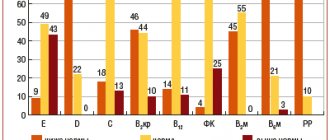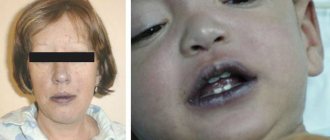- Atrophic colpitis. It occurs due to a decrease in the level of female sex hormones (estrogens) in the body, as a result of which the vaginal epithelium becomes thinner and colonization of the vagina with lactobacilli decreases. Conditions favorable for the development of infection are created. The provoking factors of the disease are: old age, artificial menopause, taking certain medications. drugs. The main symptoms of atrophic colpitis in women: itching and dryness in the vagina, discomfort during intimacy.
- Candidiasis colpitis. In the photo, colpitis in women looks like redness of the vaginal mucosa and its covering with a white coating. This form is caused by fungi of the genus Candida - opportunistic microorganisms. Infection with yeast colpitis can occur after anal/oral sex, due to decreased immunity and dysbiosis. The problem can also be a consequence of long-term antibiotic therapy or pregnancy. Colpitis is especially often diagnosed during pregnancy in the third trimester.
- Trichomonas colpitis. The most common form. The cause of trichomonas colpitis is trichomonas. Infection occurs during unprotected sexual intercourse, through household items. Immediately after entering the vaginal cavity, Trichomonas begins to multiply and infect mucosal cells. Discharge and a whitish coating appear.
Causes
The causes of colpitis are different.
These include disturbances in the functioning of the body, infections, and injuries. Each of the provoking factors leads to an acute inflammatory process and an imbalance in the bacterial microflora of the vagina. Colpitis can develop as a result of:
- Infections with sexually transmitted infections. During unprotected sexual intercourse, pathogenic microorganisms travel from the infected mucous membrane of the partner to the vaginal mucosa. A healthy own microflora does not allow microbes to multiply, but due to weakened immunity, dysbacteriosis or microtrauma, an inflammatory process can begin. Some opportunistic microorganisms contribute to the occurrence of colpitis even in the absence of associated complications. Colpitis is caused by STIs: trichomoniasis, chlamydia, gonorrhea, ureaplasmosis, genital herpes.
- Mechanical damage to the vaginal mucosa. This refers to microtraumas that appear for various reasons (usually due to insufficient hydration of the vagina during sexual intercourse, or the insertion of foreign objects). Because of them, the integrity of the mucous membrane is disrupted, bacteria enter the thickness of the tissue and begin to actively multiply there. The normal balance of microflora is disrupted.
- Long-term use of antibacterial drugs. Broad-spectrum antibiotics destroy not only the pathogen, but also normal microorganisms, so dysbacteriosis develops, and with it colpitis.
- Diseases of the endocrine system. If the ovaries produce insufficient amounts of female hormones, the risk of developing atrophic colpitis increases sharply. Therefore, the cause of the disease includes any pathology that leads to a decrease in the amount of estrogen (diseases of the adrenal glands, pancreas and thyroid glands).
- Nutritional disorders of the mucous membrane. Impaired blood circulation can deprive healthy mucous membranes of the ability to protect the body from the penetration of pathogenic microorganisms. If an insufficient amount of blood enters the tissue of the vaginal walls, the membranes become thinner, and micro tears easily form on them. Mucous cells stop producing normal physiological secretions, and the pH in the vagina changes. Also, the nutrition of the mucous membranes may be disrupted due to a lack of vitamins in the body (especially vitamin A).
- Local allergies. They can be caused by lubricants, condoms, ointments, and suppositories. The mechanism of development of allergic colpitis is associated with the work of local immune cells. When allergens fall on them, they trigger a chain of biochemical reactions. As a result, the body begins to struggle with the foreign material, and the mucous membrane becomes inflamed.
- Failure to comply with personal hygiene rules. Residues of urine, menstrual blood, vaginal discharge, not eliminated in time, are an excellent environment for the development of pathogens.
- Decreased immunity. A weakened immune system itself cannot be the cause of vaginal colpitis, but it creates all the conditions for the development of this disease. Therefore, inflammation of the genital mucosa is more often encountered by women who have suffered severe infectious diseases, a bone marrow transplant procedure, oncology, suffer from HIV/AIDS, have poor nutrition, and have been using hormonal and antibacterial drugs for a long time.
general information
Vaginitis, vulvovaginitis and colpitis occur in sexually active adult women, virgins, adolescents and children, as well as in menopausal and elderly women. And in general, it is not so easy for a woman to have a beautiful and clean vagina. Let's be honest. It requires much more money than most other organs. Unfortunately, some of the well-intentioned efforts we put into making him look good and healthy, such as deep bikini waxing, crotch shaving, "scented soap washes," etc. In the end, it only aggravates everything and causes colpitis. The reasons, acting individually or together, lead to the appearance of bad, sometimes purulent vaginal discharge, significant irritation, rash, terrible itching...
Sometimes the question arises: “Does colpitis occur in men and what is it?” This formulation is incorrect - a man does not have a vagina, and therefore there cannot be inflammation. Therefore, if representatives of the stronger sex end up on this page from a search, then this is clearly happening by mistake - there is nothing here and cannot be!
Causes of colpitis
Girls' vaginas can become inflamed for the following most common reasons:
- STDs (trichomoniasis, thrush, gonorrhea, mycoureaplasmosis, etc.)
- Endocrine disorders (ovarian diseases, obesity, diabetes).
- Hormonal changes during puberty, pregnancy, menopause.
- Uncontrolled or prolonged use of antibiotics.
- Poor intimate hygiene.
- Weakening of the immune system.
- Injuries to the vaginal mucosa.
- Allergic reactions to anything.
- Vascular pathologies that impair the nutrition of the mucous membrane.
- Senile atrophy of the vaginal mucosa.
The consequence of these reasons is a disruption of the natural microflora - vaginal dysbiosis, with its further colonization by atypical microorganisms, which cause an inflammatory reaction in the genital tract.
How inflammation develops
Problems are inevitable if the number of pathogens entering the reproductive tract is too large. Inflammation in the vagina can be caused by E. coli, staphylococci, gardnerella, and streptococci. Disruption of the normal vaginal microflora can occur due to the above reasons, as well as excessive sexual activity.
Depending on the location of the primary source of infection, the following are distinguished:
- primary colpitis - it immediately develops in the vagina, and
- secondary colpitis: • ascending - the infection comes from the external genitalia, urethra, anus; • and descending - during the transition of inflammation from the uterine cavity.
Recently, specific colpitis caused by mycoplasmas and chlamydia has become increasingly common, which can occur in mixed forms, often in virgin girls. If bacterial vaginitis is not treated, complications can occur. Inflammation can spread to the cervical canal, cavity and appendages. The consequence of an ascending infection can be cervical erosion, cervicitis, endometritis, and in advanced cases - adhesions and infertility. The likelihood of infection increases with sexual intercourse during menstruation.
Symptoms of colpitis
Signs of the disease in women depend on the cause of inflammation in the vagina. The course of colpitis can be acute, subacute, sluggish, chronic, latent and asymptomatic. All its forms are characterized by one important symptom - the inflammatory nature of vaginal discharge, the so-called. "leucorrhoea". Their character is determined by their origin (tubal, uterine and vaginal leucorrhoea is liquid, cervical leucorrhoea is mucous). An admixture of pus in the discharge usually indicates an inflammatory process, while blood often indicates the development of a tumor.
Acute colpitis
In the acute stage of the disease, the amount of leucorrhoea increases sharply. They may have an unusual consistency, color, pungent odor, and are often accompanied by burning and itching in the intimate area, pain during sexual intercourse. Based on the nature of the discharge, one can assume the most likely cause of inflammation. Often the symptoms of colpitis are accompanied by urinary disorders in the form of cystitis and pain in the lower abdomen or back.
The temperature usually does not increase in acute colpitis of a nonspecific nature, or slightly in case of deep damage to the vaginal walls. As a rule, a high temperature is typical for the clinic of colpitis of gonorrheal or trichomonas origin. Very often it is accompanied by copious, foul-smelling discharge that contains pus or even blood. Flowing down the inner surface of the thighs, in advanced cases, such secretions cause severe irritation of the skin, which makes it difficult to walk. A woman experiences a burning sensation and painful itching in the vagina, in the area of the external genitalia.
When the inflammatory process becomes chronic, the symptoms become mild. But the most stable symptom is itching in the genital area, which does not stop even with a decrease in the amount of discharge.
Chronic colpitis
At this stage, the main complaints are about discharge from the genital tract, and less often, itching and discomfort in the vaginal area. The disease is characterized by a long course and a tendency to relapse.
In chronic colpitis, the symptoms are erased, swelling and hyperemia are not expressed, there may be multiple or focal dilatations of blood vessels. The vaginal epithelium with significant structural changes may disappear in one area or another. Pus appears to be released directly from the vaginal walls, which become thick and rough.
The chronic form of colpitis has the following symptoms:
- Burning and itching in the vagina;
- Pain during sexual intercourse;
- Heaviness in the lower abdomen;
- Bloody discharge from the genital tract;
- Purulent discharge, often with an unpleasant odor;
- Redness of the vaginal mucosa.
Atrophic colpitis
During menopause and menopause, with an inevitable reduction in the amount of estrogen produced by the ovaries, women may develop age-related colpitis. Due to a decrease in the number of lactobacilli, which perform a protective function, during the menopausal period, opportunistic microorganisms actively multiply in the vagina, which provoke local inflammatory reactions and increased discharge.
In senile (senile) colpitis, the mucous membrane is atrophic, has a pale yellow color, and hemorrhagic spots and granulating tissue defects are located on its surface. Wrinkling of the submucosal tissue occurs. This leads to narrowing of the lumen and atrophy of the vagina or even fusion of its walls. This leads to the activation of pathogenic microflora of the vagina, as well as the creation of favorable conditions for the penetration of pathogenic bacteria from the outside.
With atrophic colpitis, symptoms in older women are practically absent. The disease progresses indolently, patients may have no complaints. The most common symptoms are burning and itching, a feeling of “tightness” in the vagina and dryness. Intimacy is painful, followed by bloody discharge or even minor bleeding. When examined in the speculum, a pale pink, thinned mucosa with many pinpoint hemorrhages is revealed. Often, due to vaginal dryness in atrophic colpitis, insertion of gynecological speculum is difficult.
Tormented by atrophic menopausal colpitis?
Vagina rejuvenation
Beauty and health procedures
help_outline
What is intimate rejuvenation
Symptoms of colpitis
The characteristics and intensity of symptoms of colpitis may vary. It depends on the duration of the disease and its causes. Regardless of the clinical form of the pathology, the signs are exclusively local in nature. General manifestations - fever, muscle/headaches, weakness, increased fatigue - are possible only with purulent colpitis.
Among the most common symptoms of colpitis:
- Vaginal discharge observed in any phase of the menstrual cycle. In the bacterial form they are abundant, containing gas bubbles. For candidal colpitis - curdled, in the form of flakes. In the trichomonas form, they are dirty green, sometimes foamy.
- Smell. During their life, fungi decompose chemicals (proteins, sugars) and release gases. Because of this, the smell of rotten fish appears (this symptom is not typical for candidal colpitis).
- Mild abdominal pain that gets worse during urination. They are caused by irritation of the inflamed vaginal walls by substances contained in urine. Also, discomfort becomes more pronounced during sexual intercourse.
If you experience similar symptoms,
consult your doctor . It is easier to prevent a disease than to deal with the consequences.
Pathogens
Treatment of vaginitis will largely depend on the causative agent of the disease. The cause of the pathology is an infectious lesion of the mucous membranes; depending on its source, the following types of colpitis are distinguished:
- bacterial, the causative agent is pathogenic and saprophytic bacteria;
- a viral, pathological process on the mucous membrane is caused by HPV, herpes virus and others;
- fungal, most often these are fungi of the genus Candida.
Diagnostics
The doctor can make a preliminary diagnosis of “Colpitis” immediately after listening to the patient’s complaints and examining her in a chair, during which a strong inflammatory process is revealed. The only difficulty is that it is necessary not only to identify the disease, but also to understand its cause. Very often, colpitis accompanies other gynecological diseases and is a consequence of disturbances in the functioning of certain systems and organs.
Collecting information if colpitis is suspected involves the following procedures:
- Ultrasound of the pelvis;
- standard gynecological examination using speculum;
- colposcopy (examination of the vagina using a microscope);
- rectal examination (digital/visual inspection of the rectum for fistulas);
- amiotest (aimed at determining a specific odor);
- bacteriological and cytological analyses;
- blood test (general, biochemical, hormones);
- Analysis of urine.
The gynecologist faces the following tasks:
- determine the exact boundaries of the emerging inflammatory process;
- exclude the presence of inflammation in the uterus, its appendages and cervix;
- identify the pathogen (if we are talking about infectious colpitis);
- analyze dysbacteriosis;
- check the level of estrogen in the blood;
- determine which antibiotics microbes are resistant to;
- check for structural changes in the vaginal mucosa,
- detect chronic diseases that may affect the course of colpitis.
Restoration of normal microflora
The second stage involves restoring vaginal function, increasing protective properties by restoring normal own microflora and reducing relapses of the disease. Biological agents
- Acylact (suppositories) 1 piece at night for 10 days,
- Lactonorm 1 capsule in the vagina at night for 7 days,
- Vagilak 1 capsule per day orally for 2 to 4 weeks,
- Provag 1 tablet per day with meals for 20-30 days.
The choice of drugs is made taking into account individual intolerance, allergic reactions, and the presence of concomitant diseases. Therapy should be aimed at eliminating the symptoms of the disease, eliminating risk factors, and clinical recovery.
Treatment of colpitis
Treatment of colpitis must be comprehensive - include local and general therapy. It involves eliminating the symptoms of the inflammatory process and fighting the infection that provoked it. Doctors pay maximum attention to increasing the body’s protective properties.
The basic principles of treating colpitis include:
- etiotropic therapy;
- restoration of vaginal microflora;
- treatment of the sexual partner;
- increasing immunity;
- physiotherapy;
- treatment of existing concomitant diseases.
Etiotropic therapy
Etiotropic therapy for colpitis is aimed at eliminating the main cause of the disease. It involves the use of antiviral, antibacterial and antimicrobial drugs. Nonspecific colpitis is treated with combined broad-spectrum drugs that eliminate fungal/bacterial infections. The vagina is douched with antiseptics (chlorhexidine, furatsilin), tampons with sea buckthorn oil and galascorbine are inserted inside. Additionally, take Dalacin, Betadine, Metronidazole, Clotrimazole, Diflucan or Terzhinan tablets.
Features of the treatment of specific colpitis depend on the pathogen:
- the candidal form is treated with antifungal drugs;
- bacterial - antibiotics (a preliminary study is necessary to determine the sensitivity of the identified microbes to antibiotics);
- trichomonas - "Metranidazole" (if trichomonas colpitis is diagnosed during pregnancy, treatment with "Metranidazole" is not carried out in the first trimester).
Also, to eliminate the symptoms of colpitis, suppositories (Nystatin), Ketoconazole cream, Ampicillin and Tetracycline tablets, and Metronidazole vaginal tablets can be used.
Restoration of vaginal microflora
Eubiotics help restore the vaginal microflora after using antifungal and antibacterial drugs. These are lactic acid bacteria that can inhabit the vaginal lining and thus restore their acidity. Their intake prevents the proliferation of pathogenic microorganisms.
The drugs for the treatment of colpitis have proven themselves well: Vagilak, Lactobacterin, Biovestin, Bifidumbacterin.
Treatment of sexual partner
If colpitis is caused by a sexually transmitted infection, simultaneous treatment of both sexual partners is necessary. This is done in order to prevent re-infection and relapse. During treatment you should avoid having sex. Intimate relationships are allowed only after passing a control test taken from both the man and the woman.
Boosting immunity
To increase the body's resistance to pathogens and speed up the recovery process, the patient is prescribed:
- heliotherapy (solar therapy);
- vitamin and mineral complex;
- thalassotherapy;
- laser irradiation of blood.
Physiotherapy for colpitis in women
Physiotherapy is not recommended for all women diagnosed with colpitis. They are usually used in cases of chronic disease. With the help of physiotherapy, itching is relieved, local immunity is stimulated, inflammation is eliminated, and fungal/bacterial intoxication is reduced.
The patient may be prescribed:
- zinc electrophoresis;
- ultraviolet short-wave irradiation;
- half-baths with potassium permanganate;
- low-frequency UHF therapy.
Treatment of existing concomitant diseases
For colpitis treatment to be successful, concomitant diseases must be eliminated. So, with hypofunction of the ovaries, correction of their activity is carried out. If a woman has serious chronic diseases (thyroid, diabetes), stable remission is achieved.
Treatment of colpitis during pregnancy
Treatment of colpitis in pregnant women is based on determining the type of pathogen and selecting safe and effective medications. The difficulty of therapy lies in the impossibility of using many drugs.
Treatment tactics for colpitis in pregnant women:
- exclusion from the diet of fatty, spicy and fried foods;
- refusal of sexual activity for the duration of treatment;
- antibiotic therapy (“Josamycin”, “Erythromycin”, “Rovamycin” - medications are selected by a gynecologist);
- antifungal therapy (if candidal colpitis) in the form of ointments and suppositories (“Nystatin”, “Clotrimazole”, “Limafucin”).
Vaginal sanitation
General action drugs most often used in modern conditions:
- Clindamycin 300 mg x 4 times a day, 7 days,
- Doxycycline 100 mg x 2 times, daily, for 10-14 days,
- Nystatin, Levorin 500 mg x 4 times a day for 10 -14 days.
For vaginitis caused by yeast-like fungi:
- Mikosist, Diflucan 150 mg once.
As part of complex therapy, the antimicrobial drug Trichopolum is widely used with good effectiveness and tolerability, 1 tablet x 2 times a day.
For mixed infections, local drugs are used:
- Terzhinan,
- Klion-D,
- McMirror-Complex
These drugs allow you to quickly relieve the symptoms of inflammation in the acute stage. The drugs are used by injection into the vagina, they cause rapid death of the pathogen and help restore the normal concentration of lactic acid bacteria and the acidity of the vaginal contents.
Drugs with a wide spectrum of antimicrobial action have a good effect in mixed infections:
- Betadine 1 vaginal suppository per day, 7-14 days,
- Hexicon 1 suppository x 2 times a day for 10 days. Before receiving test results, an antiseptic with a broad spectrum of activity is used
- Fluomizin.1 vaginal tablet per day x 6 days quickly relieves symptoms of vaginal inflammation.
- Epigen-intim spray 3-4 times a day for 7-10 days quickly relieves symptoms of vaginal infection, itching, burning.
Diet for colpitis
Following a diet for colpitis makes it possible to strengthen the immune system and speed up the process of restoration of damaged mucous membranes. During treatment, a woman should consume:
- food products that contain polyunsaturated acids (tuna, cod, shrimp);
- dairy products;
- vegetables, grains, fruits.
You should avoid heavy foods (fatty, fried) and alcohol. They interfere with the normal functioning of the liver, contribute to the exacerbation of chronic diseases, which ultimately leads to inhibition of the recovery process in the vaginal mucosa.
Danger
If treatment is prescribed correctly, there is no threat to the woman’s health. But self-medication, as well as complete ignorance of the symptoms of the disease, can cause inflammation of the fallopian tubes, uterus, cervix, and ovaries. This negatively affects reproductive health, leading to recurrent miscarriage or infertility.
The presence of dangerous complications of colpitis is indicated by:
- disruptions of the menstrual cycle;
- amenorrhea;
- difficulties associated with conceiving a child;
- severe pain in the lower abdomen;
- vaginal bleeding.
Femoflor
Now there is a modern method for diagnosing disorders of the vaginal microflora - Femoflor. Femoflor is a modern technique for studying the urogenital tract in women. This method is based on the use of polymerase chain reaction. The peculiarity of the Femoflor-16 method is that it provides information about the general state of the microflora and the presence of pathogens, accurately determining their quantitative value. Thanks to this, pathologies are identified, their level of development is determined, and a treatment plan for these disorders is selected. Femoflor-16 is an advanced type of analysis. Detects the presence or absence of the following groups of microorganisms: yeast-like fungi, ureaplasma, mycoplasma, streptococci, staphylococci, gardnerella, fusobacteria, leptotrichia, prevotella, eubacteria, peptostreptococci, veillonella, enterobacteria. Normal Femoflora-16 indicators indicate a balance between beneficial and opportunistic flora and that the patient is healthy. To obtain reliable test results, it is necessary to follow the rules for collecting material.
Prevention
There are no vaccines to prevent the development of colpitis. To reduce the risk of infection, you need to:
- see a gynecologist once a year (during a standard examination in a gynecological chair, the doctor can easily identify the first symptoms of the inflammatory process and immediately prescribe effective therapy);
- strictly observe the rules of personal hygiene (wash the external genitalia twice a day with warm water and soap or intimate hygiene product from front to back);
- strengthen the immune system, eat well, take vitamins and minerals;
- do not self-medicate with antibiotics;
- have one regular sexual partner.
At the first symptoms of colpitis, you should immediately make an appointment with a gynecologist.
. A disease detected at an early stage is much more treatable. If you do not visit a doctor on time, colpitis can become chronic or cause complications (abscess, fistula). Also, if left to chance, the infection can spread to the uterine cavity and lead to infertility.
This article is posted for educational purposes only and does not constitute scientific material or professional medical advice.
Colposcopy
Colposcopy is an examination of the cervix, vagina and vulva under a microscope. This is necessary for diagnosing major diseases and oncological conditions of the cervix, vagina and vulva. It is not performed against the background of vaginitis, since the image with inflammation may be incorrect - the changes that the doctor sees will disappear after treatment. When signs of vaginitis appear, treatment is carried out first, and only then colposcopy and a smear for oncocytology. Treatment of vaginitis does not require functional, radiation or instrumental diagnostics.
Determination of antibodies to sexually transmitted diseases
If you suspect an STD, you can have a blood test done to look for antibodies to infectious agents. The analysis will show whether the patient is currently or has been sick with sexually transmitted diseases.
Preparation before taking smears and bacterial cultures for sexually transmitted infections:
- Avoid sexual intercourse 2 days before taking the material.
- Do not use tampons for 7 days.
- Do not use vaginal medications or vaginal contraceptives 7 days before the test.
- It is recommended to undergo examination after menstruation. Optimally before ovulation. But if the process is acute, then there is no need to wait; it is recommended to take tests on any day of the cycle, with the exception of menstruation.
- After colposcopy, tests can be taken only after a week.
- If you have taken antibiotics or medications containing narcotics, you must wait 2 weeks before testing.
- On the day of the examination, you cannot perform personal hygiene using cosmetics.
- Before taking the test, do not urinate for 2 hours.









